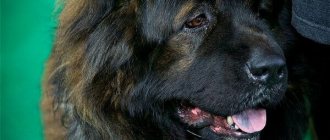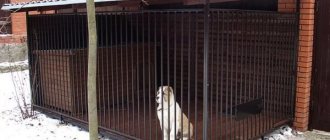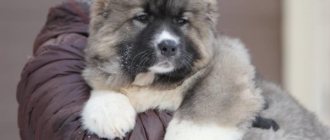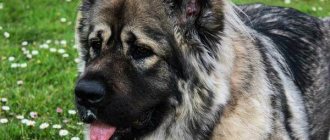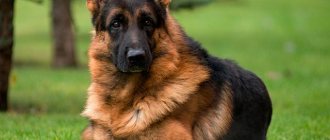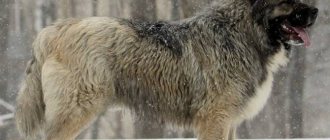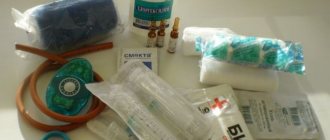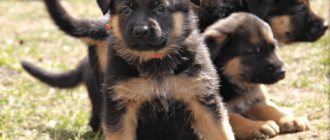Caucasian Shepherds are strong and robust dogs, distinguished by their strong character and good health.
Living in high mountains, long journeys to new pastures and fights with wolves made them resistant to cold and precipitation.
And also to many diseases.
But how long can a Caucasian Shepherd live and what needs to be done in order to prolong its life?
And how should you care for an aging pet of this breed?
Life expectancy of a standard Caucasian Shepherd dog in boys and girls
Caucasian Shepherds live on average 9-12 years . At the same time, the lifespan does not depend too much on the gender of the dog. Although, some females with age begin to suffer from serious pathologies of the reproductive system, which is why they live less than they could.
At the same time, male dogs can also suffer from diseases of the genitourinary organs, which reduce their life expectancy.
The lifespan of Caucasian Shepherds is not related to the gender of the animal.
It is much more strongly influenced by other factors, such as, for example, conditions of detention, care, illnesses suffered in youth.
The minimum lifespan of Caucasian Shepherds is 9 years, the average is 11, and the maximum lifespan of a pet of this breed is 15 years..
Expert opinion
Kozhevin Semyon Kirillovich
Expert dog handler.
“Under proper maintenance conditions, a Caucasian Shepherd can live 12-15 years. And what its life expectancy will be depends not least on how the owner treats the pet. If he takes care of the shepherd dog, tries to provide it with adequate nutrition and good care, such a dog has a much greater chance of becoming a long-liver than an animal that has spent its entire life in an enclosure or on a chain and eating low-quality food. Heredity also matters: Caucasian Shepherds from healthy lines live longer.”
Health
How long does a Caucasian Shepherd live on the street? If you feed her properly, walk her and care for her properly, she can live up to 13 years. The average life expectancy of representatives of the breed is 11 years.
The dog is aboriginal, primitive. There are no special health problems. But, like many large dogs, problems with the hip joints sometimes occur.
By old age, a pet can become blind and deaf. He begins to walk poorly, lies down more and almost does not react to external stimuli. Although he still barks loudly and menacingly.
How many live on the street, on chains and at home?
Caucasian Shepherds were originally bred to work in high altitude conditions, where sudden changes in temperature and precipitation are common..
The long, thick hair of these dogs provides them with a comfortable existence in cool and even cold temperatures, but they tolerate heat and stuffiness more difficult.
In a yard or enclosure, if there is a warm kennel and a canopy that protects from rain, snow and direct sunlight, a Caucasian Shepherd Dog can live 11-12 years, and, if lucky, even more.
Chain existence has a negative impact on the psyche and well-being of this intelligent and formidable animal and reduces its life expectancy . Such dogs usually live no more than 7 years.
If you keep a Caucasian Shepherd in a house or apartment, this also does not contribute to its longevity, since the dog will suffer from heat, stuffiness and low air humidity during the heating season.
Lack of exercise due to apartment living will also not have a very good effect on the pet’s well-being.
Caucasian Shepherd Dogs live 9-10 years in urban conditions.
Dogs of this breed live the longest in the courtyard of a private house or in an enclosure, provided that they are fully fed and cared for.
What influences physical development
Many factors influence a puppy's physical development. The influence begins from the moment the puppy appears in the mother’s womb, and not just from the moment of birth.
Reasons affecting the development of offspring:
- Living conditions of the mother and the course of pregnancy;
- The parents of the litter do not have genetic diseases;
- The general health of the mother before mating and her ability to bear offspring;
- A place where puppies are kept after birth;
- Feeding with breast milk;
- First complementary foods and its quality;
- Deciding what food to give puppies - natural or dry. It is important to take into account that only their quality affects, that is, if store food is high-class and natural food is balanced, this will only have a positive effect on the height and weight of the offspring;
- Physical activity and the puppy being in the fresh air.
It is important to understand that the prenatal period of a puppy’s development is as important as all the others.
The mother needs proper care, good nutrition, and you should not overload her with physical activity or affect her mental state . All this is directly related to how the puppies are born.
During the suckling period, you need to ensure that each of the litter receives its share of milk. Make sure that the stronger ones do not push away the smaller ones, intervene if you notice this.
After weaning from the mother, a period of intensive growth begins . Here you need to lay a real foundation in the puppy’s body.
This period cannot be missed, because its future physique, build, character and size depend on how the dog ate during it.
How to determine age?
The easiest way to determine a dog’s age is by the condition and color of its , as well as by its teeth and eyes :
- Teeth . By the age of 2.5 years, the middle incisors on the lower jaw begin to wear out, and the teeth themselves are no longer as snow-white and shiny as before. By the age of three, abrasions also appear on the upper hooks, and at 4 years - on the middle upper incisors. By the age of five, the fangs wear off and look dull. At the age of 6, teeth begin to turn yellow and tartar forms on them faster. Older animals may even begin to lose some of their teeth.
- Wool . With age, the coat becomes coarser and less shiny. At 6-7 years old, the first gray hair appears on the Caucasian Shepherd's face. Later it spreads to the entire face and forehead of the animal.
- Eyes . After the pet turns 7 years old, its eyes appear deeper set. Dilation of the pupil and clouding of the lens caused by senile ailments may occur.
Having noticed one or more of the signs of aging in a pet, the owner needs to reconsider its diet and living conditions..
Puppy weight and sizes for male and female from 1 to 12 months
Keeping track of your pet's weight and height is an essential part of owning a dog. It is important because without this surveillance you will not be able to notice deviations in the development of the dog.
Indifference in this regard can turn out to be disastrous, because often when a puppy lags behind its peers in physical development, this can indicate serious health problems.
| Dog's age (in months) | Male weight (grams) | Bitch weight (grams) | Male height (cm) | Bitch height (cm) |
| 1 | 4000-6800 | 2500-4500 | 24-26 | 23-25 |
| 2 | 13000-19600 | 11500-18000 | 34-37,5 | 33-35,5 |
| 3 | 18000-32000 | 165000-30000 | 45-49 | 43-46 |
| 4 | 25000-60000 | 22000-50000 | 51-55,5 | 48,5-51,5 |
| 5 | 35000-64000 | 32000-60000 | 57-62,5 | 54-57 |
| 6 | 40000-94000 | 35000-92000 | 63-68 | 59-63 |
| 7 | 41700-99000 | 35700-96200 | 64-70 | 60-65 |
| 8 | 43400-104400 | 36500-100600 | 65-72 | 61-67 |
| 9 | 44800-109500 | 37200-104800 | 66-74 | 62-69 |
| 10 | 46200-114600 | 38000-109000 | 66,5-75 | 63-70 |
| 11 | 47600-125000 | 38600-113200 | 67,5-76 | 63,5-71 |
| 12 | 50000-125000 | 40000-115000 | 68-78 | 64-72 |
Main causes of premature death
- Heredity . Dogs of some lines live longer than representatives of others. In addition, hereditary diseases can also significantly reduce life expectancy.
- Infections . Transferred at an earlier age, they do not pass without leaving a trace on the pet’s body and greatly affect its life expectancy. For example, a disease such as hepatitis can negatively affect the condition of the liver, which may not be noticeable in young years, but will certainly affect it with age.
- Chronic diseases . If one of these ailments appeared in youth, then with a high degree of probability it will develop again in an older pet, and they are much more severe in older dogs than in younger years.
- Accidents . They can occur due to the fault or oversight of the owners, for example, if the owner left the gate open, and the dog ran out into the street and was hit by a car.
In order to prevent household poisoning, the owner of a Caucasian Shepherd dog needs to be careful and follow safety precautions when treating a house or garden against pests, as well as when working with paints, varnishes and other chemicals.
Historical reference
The distribution area of the breed is the territories adjacent to the Caucasus Range, as well as the steppe regions of southern Russia. The formation of the breed occurred not only as a result of natural selection, but also under the influence of the national traditions of the peoples of the Caucasus.
Historically, Caucasian Shepherd Dogs were used to protect herds and homes from predators and aggressors. The first mention of the use of large mastiff-like dogs by the troops of the Armenian king Tigran II dates back to the 1st century BC.
Selection work with the breed began in the USSR in the late 20s of the 20th century. In the process of selection, physical strength, confidence and fearlessness, acute hearing, good eyesight, and the presence of thick, impervious to precipitation, have always been cultivated as mandatory qualities.
All this, as well as the endurance and unpretentiousness of Caucasian Shepherd Dogs, make it possible to use them in various, including the most severe climatic conditions.
How to extend the life of a pet?
In order for a dog to live as long as possible, you need to take care of it from puppyhood: feed it properly, vaccinate it on time, give it sufficient, but not excessive, physical activity.
IMPORTANT!
It is very important to pay attention to the education and training of the Caucasian Shepherd, since a well-trained and obedient Caucasian Shepherd is less likely to become a victim of an accident than an untrained animal.
It is also necessary to approach issues of breeding use responsibly . A dog that does not have access to breeding should not be bred.
It is impossible to breed females every time they are in heat, since frequent pregnancies and childbirth exhaust the animal’s body and lead to early decrepitness.
It is also better not to breed a male dog if he does not have high show scores, since after the first mating the dog may begin to run after every female in heat, which may ultimately end in his death under the wheels of a car or in the forest from hunger and thirst.
From about 6 years of age, or even earlier, you need to start carrying out preventive medical examinations in the clinic, which will help identify the first pathologies in a seemingly healthy shepherd dog and cure them in time..
Breed characteristics, abilities, training
Caucasian Shepherd: the characteristics of the breed highlight the main qualities - courage, determination and bravery. They are able to make decisions independently. They have high intelligence and lightning-fast reactions.
The standard behavior is balanced, active, confident, fearless and independent. The Caucasian Shepherd is devoted to its owner; it is an excellent guard dog.
They need to realize their main purpose - protection. They strive to constantly control their territory.
The main characteristic of the Caucasian Shepherd is that they are suspicious of anyone who, in their opinion, is not a member of the “pack”. Vigilant 24 hours a day.
Caucasian Shepherd Dogs are not inclined to overtly show aggression; in moments of danger they attack without warning.
Caucasians are classified as dogs with a balanced, mobile type of nervous system and well-developed inhibition. Conditioned reflexes are reinforced quickly and reliably.
Caucasians are stubborn, training requires experience and systematicity. With proper upbringing, the puppy immediately recognizes the owner as the leader and does not pretend to dominate.
The natural orientation of shepherd dogs towards constant guarding, alertness, and protection must necessarily be realized in the regular performance of security and guard work, and in active physical activity.
When keeping Caucasian Shepherd dogs in the city, it is necessary to socialize them. To do this, from puppyhood, the shepherd dog is walked on dog parks, places where vehicles and people gather.
Caucasians master the guard duty course well and are able to succeed in the agility course (overcoming an obstacle course).
When training, they adhere to the rule “from simple to complex.”
Proper nutrition
The Caucasian Shepherd is a large breed, and improper nutrition greatly affects the state of the musculoskeletal system of these dogs, which is why arthrosis and arthritis can develop in old age.
A pet of this breed needs high-quality food from early childhood..
The Caucasian Shepherd is fed either commercial food for large dogs, or its food is prepared separately.
You can feed your dog muscle meat, trimmings or offal, with the exception of lungs, kidneys and udders. Be sure to add porridge cooked in low-fat broth or water to the meat.
Vegetables, herbs, and lactic acid products should become an integral part of the Caucasian Shepherd's diet..
If your pet has an allergy or other disease, it should be switched to a special diet food.
What to do if your weight is below normal
In order for your dog to grow up healthy and happy, you need to pay attention to its weight . After all, not enough, as well as too much, can become the beginning of a serious disease that will have to be dealt with.
If your observation shows that there is such a deviation, then you need to act immediately. A trip to the vet will be the first thing to do. The doctor will conduct all the necessary examinations and find out what the problem is.
The most common reasons for a dog to be underweight:
- Lack of proteins, fats, vitamins;
- Parasites;
- Malnutrition;
- Short stay in fresh air or no air at all;
- The onset of hereditary or other diseases.
Once the cause is discovered, it will be easier for you to treat your pet.
If the problem is that the dog does not receive enough vitamins and minerals, then you should review the dog’s diet and include some supplements in it. This could be bone meal, calcined cottage cheese, vitamin D.
It is worth remembering that if a puppy has not received all the necessary components for normal development since childhood, then it is very difficult and almost impossible to make up for this in the future..
If it turns out that the problem is parasites, then deworming is prescribed. It should be done every month without skipping it, otherwise the weight loss will return again.
It is also worth watching how the puppy eats . If he completely licks the plate, then perhaps you should increase the portion, because your pet is simply not eating enough.
This factor can play a decisive role if the dog receives little food but is active a lot.
An examination by a veterinarian is also important because you cannot know about all the diseases that the animal is prone to and that it may develop.
The sooner the cause is discovered, the greater the chance that your pet will quickly return to his normal life and business..
Quality maintenance and care
Caucasian Shepherds feel best in the yard of a private house or in an enclosure, but not on a chain. The animal should have a warm booth and the opportunity to hide in the shade of trees or under a canopy from the sun's rays.
Caring for your dog includes brushing 2 times a week, and during shedding - every day . Exhibition animals also need professional grooming.
It is recommended to wash Caucasian Shepherd dogs no more than 2-3 times a year using special detergents.
Eyes are rubbed as needed . Teeth are brushed approximately once every 2 weeks with a special paste and brush for animals. Ears, when dirty, are cleaned using cotton swabs.
Claws are trimmed as they grow . If there is a hard surface in the enclosure or yard, you will not have to do this too often.
Standard
According to existing standards, a shepherd dog has the following characteristics:
- the head is strictly standardized. If you measure the distance from the back of the head to the tip of the nose, you will get approximately forty percent of the height at the withers,
- the body is strong and muscular. The back has a straight line,
- limbs are straight, long and parallel,
- the tail is so long that its tip reaches the hock joint,
- the tip of the nose is pigmented black,
- the eyes are oval, slightly slanted, the iris is dark brown in color,
- ears are erect, in the form of triangles,
- color strictly regulated by standards,
- the coat can be short or long, depending on the species. There is always a thick undercoat.
Caring for an older dog
An older Caucasian Shepherd becomes less active: she sleeps longer and moves less . Her hearing or vision may deteriorate, and negative traits may appear or intensify in her character.
CAREFULLY!
It is strictly forbidden to walk an elderly pet without a leash, as it can easily become a victim of an accident.
Caring for an older Caucasian Shepherd remains the same as in its youth: timely cleaning of eyes, ears, teeth and trimming of nails.
In terms of veterinary care, in addition to regular dewormings and vaccinations, annual preventive examinations in the clinic are also added..
Older dogs are prone to colds, and they often have joint pain. This is why you need to additionally insulate the kennel in cold weather and make sure that the dog has soft and comfortable bedding.
Limbs
The forelimbs are perpendicular to the ground and are relatively far apart. Muscles are physically developed. Strong, close-fitting shoulders to the chest, together with wide shoulder blades, form an angle of one hundred degrees. The elbow joints are parallel to the surface and directed straight back. Short pasterns have an almost straight structure.
If you look at the dog from behind, you will see that the hind legs are perpendicular to the ground and are moderately far apart. The clearly visible hock and stifle joints are at an angle of one hundred and fifty degrees. The thighs, shins and metatarsals are well developed physically.
All limbs end in large rounded paws.
Nicknames
A formidable and fearless dog must have an appropriate nickname that is in tune with his character and inner essence.
TOP 10 nicknames for the Caucasian Shepherd
| For boys | For girls |
| Baikal | Alba |
| Hector | Bagheera |
| Jean | Vista |
| Lock | Lada |
| Oscar | Nora |
| Rumble | Romana |
| Sarmat | Thelma |
| Typhoon | Sophie |
| Sheriff | Thira |
| Caesar | Hilda |
Of course, this table does not exhaust the list of nicknames, and the owner is free to choose the name for the pet himself.
Dog handlers recommend giving large dogs a short, sonorous name. The pet will remember it easier.
Character
The main character traits of a Caucasian are seriousness and independence. In certain situations, dogs tend to ignore commands and make their own decisions.
They are simply distinguished by their immense devotion to their owner. They are always wary or hostile towards strangers.
The dog will protect the children of his owner. It might even play a little, but it’s still not worth involving such a dog in games with children.
Caucasians, in principle, are also loyal to animals. They can share territory if the pets have known each other since childhood and there is no competition between them subsequently.
Story
There is no consensus on the origin of the Caucasian Shepherd; there are two versions.
According to the first, the ancestors of Caucasians are Tibetan Great Danes. For a long time they were raised for baiting and participating in dog fights, hence the characteristics characteristic of Caucasians - aggressiveness, seriousness, and wariness.
Supporters of the second version believe that the roots of the breed go back to the ancient state of Urartu, which once existed on the territory of modern Azerbaijan, partly Iran, Armenia and Turkey.
Possible diseases
The formation of the dog was influenced by the historical habitat. The animal is tolerant to low temperatures and resistant to diseases. Timely vaccination will minimize infectious diseases. The created conditions that meet the physiological requirements of the animal will eliminate a number of health-related pathologies.
Having become the owner of a Caucasian Shepherd, you need to know what diseases threaten it. What clinical signs are worth paying attention to:
1. Infection with plague, hepatitis, leptospirosis will be accompanied by: fever, lack of activity, refusal to feed, vomiting and diarrhea.
2. Metabolic disorders due to poor diet, risk of developing agammaglobulinemia with infectious symptoms.
3. Hormonal imbalance leads to diabetes. Signs of the disease will be weight loss, constant thirst, dry mucous membranes. Hormonal imbalance will lead to abnormal location of the testicles, dwarfism, and gigantism.
4. Diseases related to musculoskeletal function: dysplasia, sagging of the hind or front legs, lameness.
5. Pathologies of a neurological nature: neuroses, muscle spasms, epilepsy.
At the first signs of illness, you need to contact the nearest veterinary clinic for help. One of the most common diseases is obesity. If there are no disturbances in the endocrine system, then the reason is improper feeding. It is necessary to reduce the amount of food and increase the frequency of walks.
